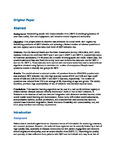Machine Learning for Risk Group Identification and User Data Collection in a Herpes Simplex Virus Patient Registry: Algorithm Development and Validation Study
| dc.contributor.author | Surodina, S | |
| dc.contributor.author | Lam, C | |
| dc.contributor.author | Grbich, S | |
| dc.contributor.author | Milne-Ives, Madison | |
| dc.contributor.author | van Velthoven, M | |
| dc.contributor.author | Meinert, Edward | |
| dc.date.accessioned | 2021-12-09T10:08:52Z | |
| dc.date.available | 2021-12-09T10:08:52Z | |
| dc.date.issued | 2021-06-11 | |
| dc.identifier.issn | 2563-6316 | |
| dc.identifier.issn | 2563-6316 | |
| dc.identifier.other | e25560 | |
| dc.identifier.uri | http://hdl.handle.net/10026.1/18449 | |
| dc.description.abstract |
<jats:sec> <jats:title>Background</jats:title> <jats:p>Researching people with herpes simplex virus (HSV) is challenging because of poor data quality, low user engagement, and concerns around stigma and anonymity.</jats:p> </jats:sec> <jats:sec> <jats:title>Objective</jats:title> <jats:p>This project aimed to improve data collection for a real-world HSV registry by identifying predictors of HSV infection and selecting a limited number of relevant questions to ask new registry users to determine their level of HSV infection risk.</jats:p> </jats:sec> <jats:sec> <jats:title>Methods</jats:title> <jats:p>The US National Health and Nutrition Examination Survey (NHANES, 2015-2016) database includes the confirmed HSV type 1 and type 2 (HSV-1 and HSV-2, respectively) status of American participants (14-49 years) and a wealth of demographic and health-related data. The questionnaires and data sets from this survey were used to form two data sets: one for HSV-1 and one for HSV-2. These data sets were used to train and test a model that used a random forest algorithm (devised using Python) to minimize the number of anonymous lifestyle-based questions needed to identify risk groups for HSV.</jats:p> </jats:sec> <jats:sec> <jats:title>Results</jats:title> <jats:p>The model selected a reduced number of questions from the NHANES questionnaire that predicted HSV infection risk with high accuracy scores of 0.91 and 0.96 and high recall scores of 0.88 and 0.98 for the HSV-1 and HSV-2 data sets, respectively. The number of questions was reduced from 150 to an average of 40, depending on age and gender. The model, therefore, provided high predictability of risk of infection with minimal required input.</jats:p> </jats:sec> <jats:sec> <jats:title>Conclusions</jats:title> <jats:p>This machine learning algorithm can be used in a real-world evidence registry to collect relevant lifestyle data and identify individuals’ levels of risk of HSV infection. A limitation is the absence of real user data and integration with electronic medical records, which would enable model learning and improvement. Future work will explore model adjustments, anonymization options, explicit permissions, and a standardized data schema that meet the General Data Protection Regulation, Health Insurance Portability and Accountability Act, and third-party interface connectivity requirements.</jats:p> </jats:sec> | |
| dc.format.extent | e25560-e25560 | |
| dc.format.medium | Electronic | |
| dc.language | en | |
| dc.language.iso | en | |
| dc.publisher | JMIR Publications Inc. | |
| dc.subject | artificial intelligence | |
| dc.subject | data collection | |
| dc.subject | herpes simplex virus | |
| dc.subject | machine learning | |
| dc.subject | medical information system | |
| dc.subject | predictor | |
| dc.subject | registries | |
| dc.subject | risk | |
| dc.subject | risk assessment | |
| dc.subject | user-centered design | |
| dc.title | Machine Learning for Risk Group Identification and User Data Collection in a Herpes Simplex Virus Patient Registry: Algorithm Development and Validation Study | |
| dc.type | journal-article | |
| dc.type | Journal Article | |
| plymouth.author-url | https://www.ncbi.nlm.nih.gov/pubmed/37725536 | |
| plymouth.issue | 2 | |
| plymouth.volume | 2 | |
| plymouth.publication-status | Published online | |
| plymouth.journal | JMIRx Med | |
| dc.identifier.doi | 10.2196/25560 | |
| plymouth.organisational-group | /Plymouth | |
| plymouth.organisational-group | /Plymouth/Faculty of Health | |
| plymouth.organisational-group | /Plymouth/Faculty of Health/School of Nursing and Midwifery | |
| plymouth.organisational-group | /Plymouth/REF 2021 Researchers by UoA | |
| plymouth.organisational-group | /Plymouth/REF 2021 Researchers by UoA/UoA03 Allied Health Professions, Dentistry, Nursing and Pharmacy | |
| plymouth.organisational-group | /Plymouth/Users by role | |
| plymouth.organisational-group | /Plymouth/Users by role/Academics | |
| plymouth.organisational-group | /Plymouth/Users by role/Researchers in ResearchFish submission | |
| dc.publisher.place | Canada | |
| dcterms.dateAccepted | 2021-03-12 | |
| dc.rights.embargodate | 2021-12-10 | |
| dc.identifier.eissn | 2563-6316 | |
| dc.rights.embargoperiod | Not known | |
| rioxxterms.versionofrecord | 10.2196/25560 | |
| rioxxterms.licenseref.uri | http://www.rioxx.net/licenses/all-rights-reserved | |
| rioxxterms.licenseref.startdate | 2021-06-11 | |
| rioxxterms.type | Journal Article/Review |


